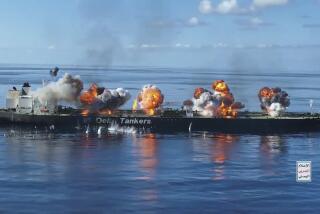Oil Platform Off Brazil Sinks and Starts Leaking
- Share via
BUENOS AIRES — A crippled Brazilian oil platform sank into the Atlantic Ocean off the coast of Rio de Janeiro and started spilling oil Tuesday, five days after explosions on the giant rig killed 10 workers and damaged the finances and image of Brazil’s state oil company.
Despite efforts to save the P-36 platform, one of the world’s largest, the 40-story rig tipped and sank rapidly about 10:30 a.m. Officials of Petrobras, the national company that still dominates Brazil’s oil industry, said some of the almost 400,000 gallons of fuel aboard the structure had begun to leak.
But cleanup crews aboard a dozen Petrobras ships were already at work. Government officials and environmentalists predicted that the ecological impact would not be grave. The quantity of oil is relatively small, the rig is about 80 miles from land, and weather conditions were expected to push the spill out to sea.
“Environmental damage . . . will apparently be small and is being taken care of,” said Jose Jorge, Brazil’s minister of mines and energy.
Petrobras officials said 90% of the oil on the platform is diesel oil, which evaporates more easily than other types of fuel, further reducing the environmental peril. Most of the fuel is likely to leak, company officials said.
The loss of the rig is a serious but not catastrophic blow to Brazil’s economy and to the country’s prestige as a leader in deep-water oil drilling. Although the rig is insured for $500 million, Brazil has lost 6% of its domestic oil output and will now have to import up to $500 million more in crude and gasoline this year, driving up its trade deficit.
The rig was a critical element in Brazil’s drive to become self-sufficient in oil by 2005, a goal that Brazilian officials still believe they can meet.
South America’s biggest economy must import one-third of the 1.9 million barrels of oil it consumes daily. The platform, which began operating last year, produced 80,000 barrels of oil a day before the accident but was slated to increase to as much as 180,000 barrels over the next year.
Petrobras might move two other oil rigs into place to take on the crude formerly pumped by P-36 from about 20 underwater wells, according to a spokeswoman. Petrobras will also step up oil production elsewhere to try to meet its goal of 2.2 million barrels of daily oil production by 2005, the spokeswoman added.
“The accident will cause a delay in production growth but not necessarily endanger the self-sufficiency target,” said oil analyst Patricia Bueno Kearns of Salomon Smith Barney investment bank in New York.
Even before Thursday’s accident, Brazil’s steadily rising imports and trade imbalance were cause for concern. The devaluation of Brazil’s currency, the real, in 1999 failed to make Brazilian exports sufficiently competitive to produce a trade surplus. Deficits leave any economy vulnerable to the costs of financing the red ink.
Brazil is also suffering the repercussions from a political and economic crisis in neighboring Argentina, which is a major trading partner.
In addition to its offshore exploration effort, Brazil has tried to spur energy self-sufficiency by breaking up the Petrobras monopoly, opening up bidding for rights to drill offshore to include foreign oil companies. Twenty-two foreign firms bought rights in auctions held in 1999 and 2000 by the National Petroleum Agency, a government group formed in 1997 partly to spur outside investment.
The cause of the three explosions that destroyed the platform has not yet been determined. Unions accuse Petrobras of sacrificing safety for profits during an aggressive drive to reduce the work force and stay competitive.
Rotella reported from Buenos Aires and Kraul from Mexico City. Paula Gobbi of The Times’ Rio de Janeiro Bureau contributed to this report.
More to Read
Sign up for Essential California
The most important California stories and recommendations in your inbox every morning.
You may occasionally receive promotional content from the Los Angeles Times.













